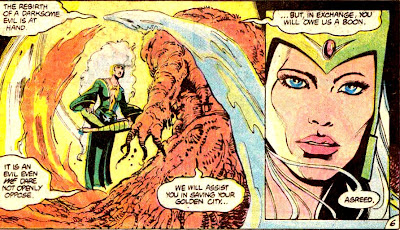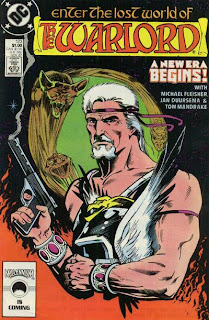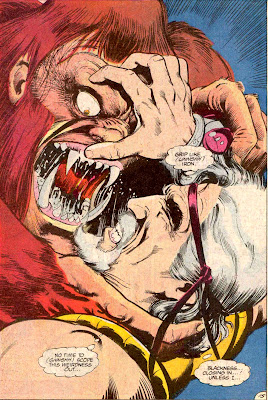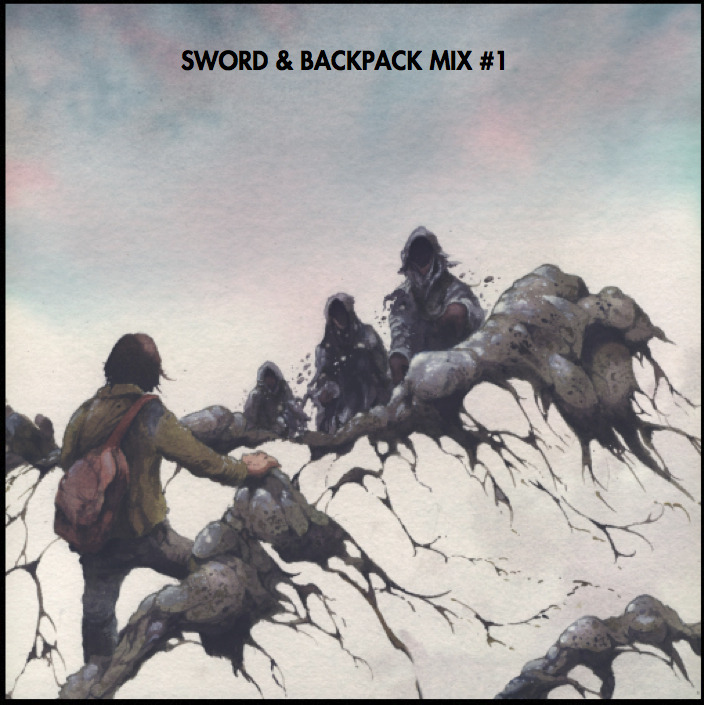Warlord #125 (January 1988)
Written by Michael Fleisher; Pencils by Jan Duursema, Inks by Tom Mandrake
Synopsis: The Shamballan survivors of the volcanic eruption numbly work to bury their dead. A cloaked figure arrives to add to their misery: the newly made Scavenger of Souls. Morgan rides up and catches him crouching over one of the dying. Morgan recognizes him and they scuffle. His barest touch on Morgan’s bare arm paralyzes it, allowing him to escape. Morgan realizes if he hadn’t pulled himself free, the touch would have killed him.
In the palace, Jennifer shares what’s she’s learned about recent events with Tara. The volcano eruption and the eclipse aren’t separate events, but harbingers of a doom that threatens the world. Jennifer has discovered an evil lurking in a cave beneath the volcano. Tara says she’ll go check it out. Jennifer suggests maybe she should wait for Morgan, but Tara sets her straight:
Jennifer gives her the magic talisman given to Morgan by V'Zarr Hagar-Zinn (is issue #114).
In that cave, the Scavenger has returned to his mistress and is regurgitating the souls he collected for her nourishment. Khnathaiti tells him her origin story: how she ruled over Mu, sucking souls, until all their greatest wizards teamed up and imprisoned her in the sarcophagus. The Scavenger isn’t paying a lot of attention as he’s watching Tara approach in the scrying pool, and drooling over her. Khnathaiti tells him he can have Tara’s body—as long as she gets Tara’s soul.
Elsewhere in Skartaris, Mariah, wandering in the wilderness, enters a cave to rest and winds up walking through to Siberia. She sees Soviet soldiers setting up a satellite dish. When a pteranodon flies past her through the cave and attacks. Mariah jumps out to help them. She repaid for her heroism by getting taken captive to be taken to the KGB.
Morgan, still feeling drained by the Scavenger’s attack collapses into bed. Shakira in cat form comes out of hiding to curl up beside him. While he sleeps, Tara enters the cave.
She encounters the last remaining lackey of Khnathaiti. A ring she’s wearing seems to drive him away, but then, the Scavenger appears. She strikes at him with her blade, but he is unaffected by mortal weapons:
Meanwhile, the dead rise in the Shamballan streets. They began shambling toward the volcano—and the cave.
Morgan wakes up. He feels a presence in the bedchamber--and he’s barely able to dodge the cloaked figure’s sword slash! Morgan pulls his own sword, but his only holding his own against his attacker. In a last ditch effort to avoid a descending blade, he flips the figure off a balcony—and see’s it’s Tara!
Things to Notice:
- Duursema has eveybody suddenly with exuberant Bon Jovi-esque hair.
- You would think Jennifer (as supreme Skartarian sorceress) might get more involved in fighting a magical menace.
Where It Comes From:
As she tells the Soviet soldiers in this issue, Mariah Romanova is indeed a citizen of the U.S.S.R. (and former national fencing champion!). It isn't something that has come up a lot since the seventies Grell issues. Morgan too emerged from Skartaris into Soviet territory (back in issue #52), though he didn't use a cave.
At this point in the history of the title, DC Comics editorial policy is that Skartaris is in a separate dimension accessible via the Poles, rather than an inner earth.
As she tells the Soviet soldiers in this issue, Mariah Romanova is indeed a citizen of the U.S.S.R. (and former national fencing champion!). It isn't something that has come up a lot since the seventies Grell issues. Morgan too emerged from Skartaris into Soviet territory (back in issue #52), though he didn't use a cave.
At this point in the history of the title, DC Comics editorial policy is that Skartaris is in a separate dimension accessible via the Poles, rather than an inner earth.


























































